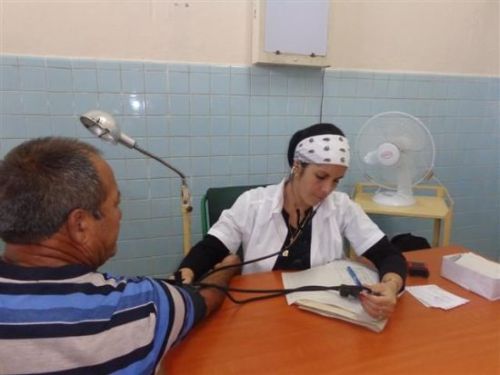Although this health facility holds the sanitary status of policlinic, it’s been serving as a hospital for over forty decades.
It might be that Camilo Cienfuegos felt himself indebted to the residents of the town of Meneses, whom he provided with the most precious value: freedom. Or maybe he didn’t want the location to be just one more in the list of territories he liberated in the northern region of the former Cuban province of Las Villas.
According to local residents, Camilo once said that a school was necessary in Meneses, and although he couldn’t see his dream come true, the school was built. Nevertheless, it was not the only institution needed over there.
Locals were hoping for years, until one day Fidel Castro showed up on occasion of his visit to a nearby road being constructed in Jarahueca.
—Commander, Camilo promised to build us a school—. These were more or less the words said by a woman to Fidel Castro. They were enough for the then Cuban president who gave his word that the educational institution would be constructed, and also advised to build a tailoring, and a small hospital.
Everyone in town got involved in the construction works. It was like another revolution in Meneses. In the end, both the tailoring and the polyclinic were constructed, the latter being the only one looking like a hospital in the inside, and resembling a house in the outside.
Everyone in town got involved in the construction works. It was like another revolution in Meneses. In the end, both the tailoring and the polyclinic were constructed, the latter being the only one looking like a hospital in the inside, and resembling a house in the outside.
A DREAM CAME TRUE
When it was first opened in October, 1973, the polyclinic was only provided with an emergency room. Later on, delivery, dental and hospitalization services were available in the health facility.
Despite the building keeps its original precast concrete structure and two halls covered with protection slabs, it’s not the same anymore. It currently cares for over 12 750 inhabitants, controls 19 doctor offices scattered in five rural settlements, and has expanded the services.
“The emergency department is open 24 hours a day —said Nursing Graduate Sailys Nepomuceno Estévez, director of the health institution—, but the facility’s also got an eight-bed admission ward, electrocardiogram, ultrasound, and X-ray services, along with a dental clinic and a rehabilitation ward”.
Although the polyclinic is not furnished with state-of-the-art equipments, the fact that neither children under one year old, nor pregnant women were reported dead last year is worth noting.
According the Nepomuceno Estévez, health indicators are well approached, and only those cases that cannot be handled in the area are transferred to another institution. Nevertheless, there are toxic habits such as smoking and alcoholism, which have not been eliminated despite the efforts made.
Dr. Denis Rodríguez Hernández, first degree specialist on General Integral Medicine, explained that patients are mostly admitted due to respiratory diseases like bronchopneumonia and bronchial asthma, circulatory system conditions and high blood pressure which is very common in the population also due to alcoholism and smoking habits, as well as aging.
Emergencies from everywhere are treated in this facility. It holds the sanitary status of policlinic, but for over forty decades, people have been calling it a hospital due to the several services available in the recently restored health institution.
 Escambray ENGLISH EDITION
Escambray ENGLISH EDITION






Escambray reserves the right to publish comments.